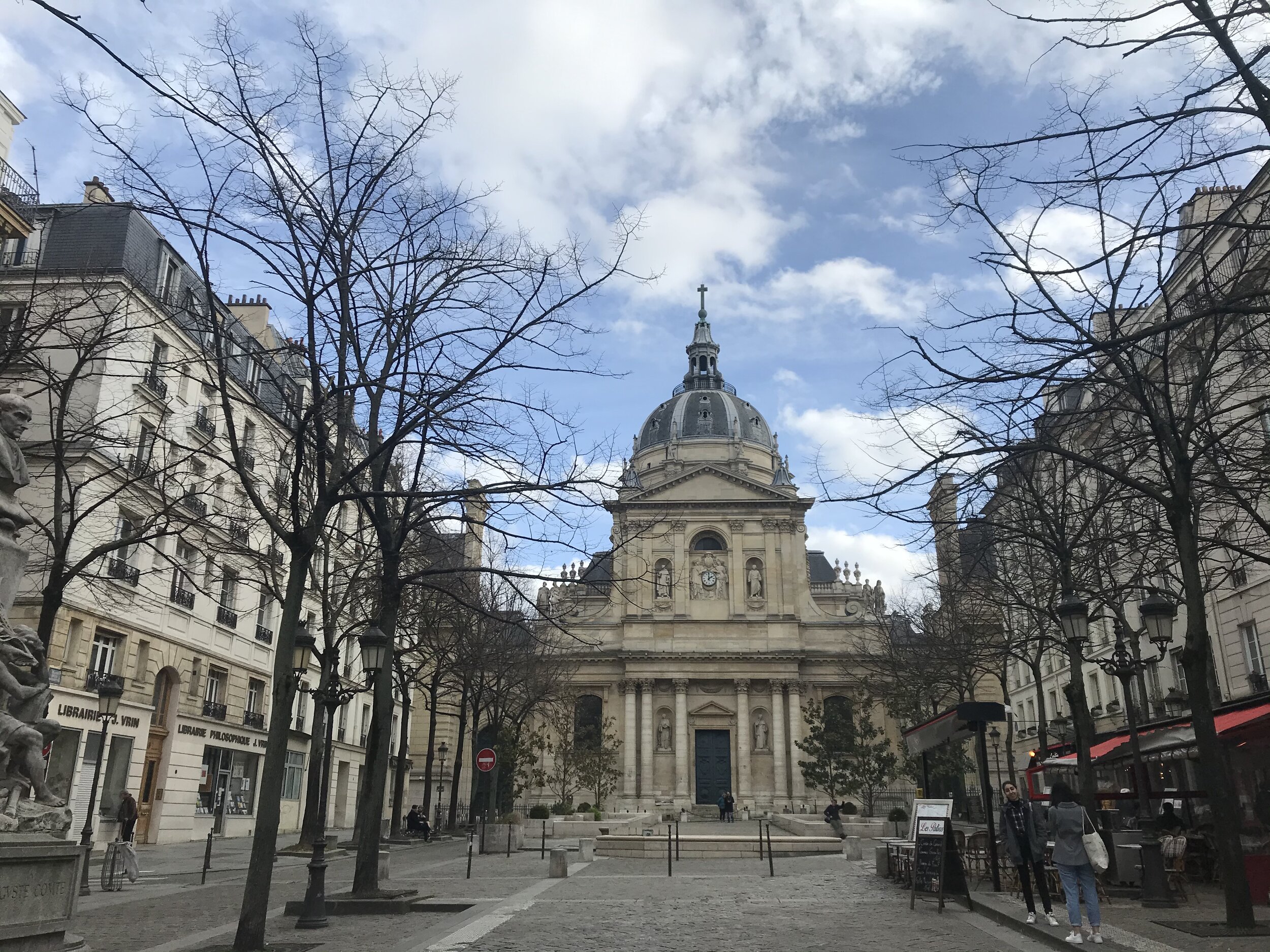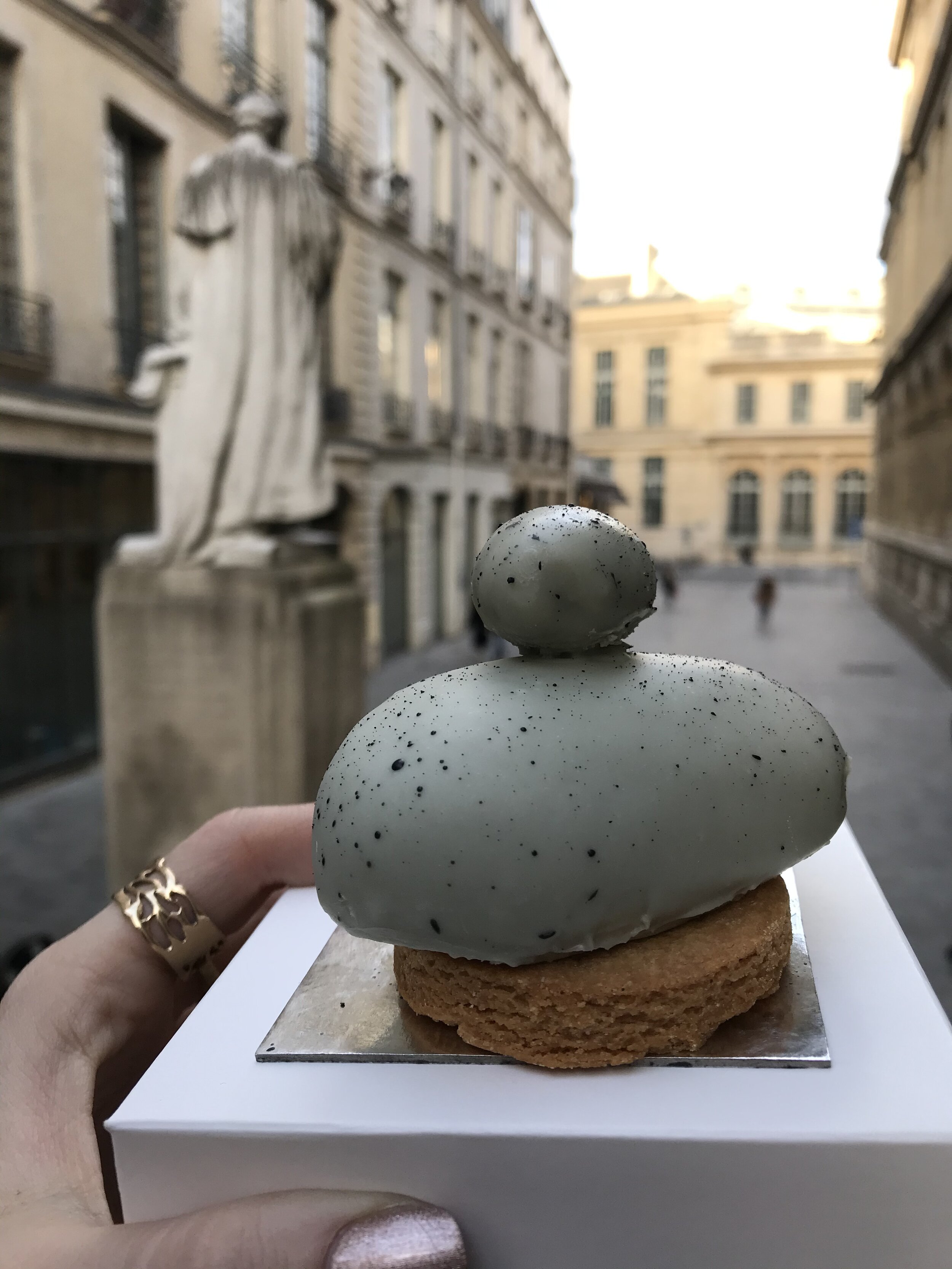Gardens, Statues & Historical Sites
Discover the beautiful parks and gardens in the Latin Quarter, as well as some of the most exciting historical landmarks and statues that make any stroll in this neighbourhood lovely.
Place Saint-Michel
A small public square across from the bridge Pont Saint-Michel, tourists flock here to take a picture in front of the famous fountain. Fontaine Saint-Michel was created mid-19th century by architect Davioud. The sculpture above the fountain, which features the archangel Saint Michel, was meant to be of Napoleon III but created too much controversy. Instead, Davioud and a team of sculptors, using bronze, created the archangel slaying the devil, surrounded by two dragons spurting water, and statues representing the cardinal virtues (prudence, power, justice, and temperance). Davioud, who designed this fountain, is also responsible for countless sculptures, gates, temples, and pavilions throughout the city’s parks.
University La Sorbonne
Founded in 1257, the university started as a school for poor theology students who were eager to learn about Christian dogma and its scriptures. Sanctioned by the Pope, the school quickly grew in numbers and became the base for the University of Paris; a campus-less university that focused on four main faculties, including theology, medicine, law and liberal arts. The campus as it’s known today took centuries to create, with expansions and additions over the years – the first proper libraries and lecture halls only added in the 1600s under the direct of Cardinal Richelieu. The university has remained standing through every major regime change, with minor closures after the Revolution until it was re-established under the French Empire early 19th century. During the 20th century, the university continued to expand, no longer all attached and with various schools throughout the Latin Quarter.






Jardin des Plantes
The Jardin des Plantes is more than just another botanical garden – it is a historical and medicinal garden in Paris, with over 10,000 species of plants houses here. Founded in 1626 by the court physician, it was opened as a royal medicinal garden. Less than 20 years later it was opened to the public, and shortly after it became more than just a place of refuge and relaxation, but a place to study plants.
Now when visiting, guests can enjoy the vast gardens and tropical greenhouses, the ménagerie (small zoo), the metal Buffon gazebo (it was one of the first of its kind in the world), the maze, and the historical galleries that focus on biodiversity and geodiversity, as well as the history of some of the species represented here. You can even take a botany workshop here if looking for a unique and memorable activity. Or simply pose with the pistachio tree that’s over 300 years old. You’ll also see a plaque outside the old science laboratories housed here commemorating Henri Becquerel’s discovery of radioactivity in 1986.
Particular gardens of interest include the Rose Garden, which features over 150 types of European roses, and the Alpine Garden that has over 2000 plants from the alps, North America, and the Pyrenees. People also tend to flock to the famous Cedar of Lebanon, which is over 40ft in circumference and has was planted in the 18th century.
Practical Information: Open daily from 7:30am-8pm during the high season (summer months into early autumn), and from 8am-7:30pm during the late autumn/early winter months. Admission to the gardens is free so you can explore the gardens as much as you want and at your own leisure. However, the various galleries and temporary exhibitions, as well as the menagerie and greenhouses, do have an entrance fee and different opening hours. As the garden’s hours and access to the public can change, please check HERE for the most up-to-date information – you can also check out the different galleries access information.
How to Get There: The closest métro stations are Jussieu (M7 and M10), Place Monge (M7), and Gare d’Austerlitz (M5, M10 or RER C).
Arènes de Lutèce
An old Roman amphitheatre, the Arènes de Lutèce is one of the last remaining – and one of the most important – symbols of the classical antiquity period of Paris, when it was then known as Lutèce (or Lutetia in English and Latin). Used for various forms of entertainment, including gladiator fights, this was a hallmark of Roman civilization.
The Roman city began development in the 1st century AD, after the Julius Caesar won the Battle of Lutetia against the Celtic tribe living there – the Parissi. Lutèce/Lutetia continued to grow successfully for the next hundred years, from the Isle de Cité across the Seine. However by the 3rd and 4th centuries, the Normans and the Franks began to attack and the Roman city became one of history.
The amphitheatre, which still remains standing and was found during an excavation in the 1860s, is free to enter and makes for a great place to sit and enjoy the sun in the summer months, while in the autumn it’s fun to join the students who gather during breaks here, looking around the stage and classical site with a hot drink in hand.
Practical Information: The grounds are open to visitors from 8:30am-9pm during the summer months, and from 8:30am-5pm the rest of the year. However, there can be closures due to possible events, holidays, or public safety (i.e. Covid-19). The grounds are free to explore.
How to Get There: While there are three entrances to the amphitheatre, the easiest ro find and access is on 47 rue Monge, where an archway leads you into the archaeological site. The closest métro stations are Cardinal Lemoine (M10), Place Monge (M7), and Jussieu (M7 and M10).
Jardin du Luxembourg (Luxembourg Gardens)
One of Paris’ most beautiful and famous parks with lavish gardens to wander and relax in. An absolute pleasure to walk through, these gardens are a must as you explore the Left Bank – a staple when exploring the Saint-Germain neighbourhood and the 6th arr. or when exploring the Latin Quarter.
While the history of the Luxembourg Gardens dates back to the 17th century, it has born witness to the great atrocities that have occurred in Paris over the centuries. From being used as a prison during the French Revolution to German barracks and bunker after the Nazis took Paris – the barracks in the palace and the bunker dug into the garden – these Italian style gardens have been a prominent figure in the city’s history.
As you stroll through the park and enjoy the central fountain, take note of the many busts and statues, many including famous queens and women of royalty. Others include famed musicians, philosophers, scientists, and politicians. Just some of the many statues include Mary Queen of Scots, Anne of Austria, Margaret of Anjou, Beethoven, and a statue of the mythological Narcissus.
How to Get There: Métro stations surround the gardens, albeit a few block away. To subway there, go to one of these stations: Luxembourg (RER B), Notre-Dame-des-Champs (M12), Renne (M12), Saint-Placide (M4) and Odéon (M4 or M10).
Enceinte de Phillipe Auguste (Wall of Phillipe II Augustus)
A quick walk-by photo op moment, as it is just a small chunk of an old medieval wall that remains amongst more modern architecture. However, it is worth passing by as it’s one of the oldest parts of the city’s infrastructure, built to defend the capital while King Phillip II (also known as Phillip Augustus) was fighting in the Crusades. He was afraid that the House of Plantagenet (the Anglo-Normal rulers of Britain) would try and seize the city. You can also catch glimpses of this medieval wall near the Marais.
How to Get There: Métro stations Place Monge (M7) and Jussieu (M7 and M10) are the closest to this wall. If walking from Saint-Michel, pass by this wall before heading to the Jardin des Plantes.


















